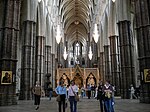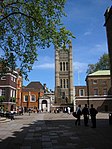Westminster Abbey Muniments
Archives in the City of WestminsterEnglish manuscriptsWestminster Abbey
The Westminster Abbey Muniments is a collection of muniments and manuscripts comprising archives of Westminster Abbey from the tenth century to the present day. The core of the collection contains accounts, manuscripts, and court records of the large estate. Before they were put together in the archives, they were scattered across southern and mid-England.
Excerpt from the Wikipedia article Westminster Abbey Muniments (License: CC BY-SA 3.0, Authors).Westminster Abbey Muniments
Way of the Monks, London Millbank
Geographical coordinates (GPS) Address Phone number Website Nearby Places Show on map
Geographical coordinates (GPS)
| Latitude | Longitude |
|---|---|
| N 51.498888888889 ° | E -0.1275 ° |
Address
Westminster School
Way of the Monks
SW1P 3PF London, Millbank
England, United Kingdom
Open on Google Maps









